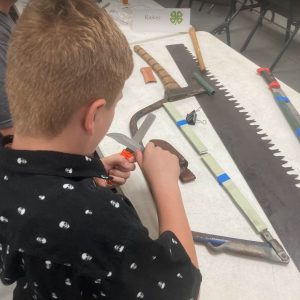
In Florida 4-H, there are five shooting sports disciplines: archery, rifle, shotgun, muzzleloading, and hunting. While all are popular among kids and families, the hunting discipline is the most varied. Kids love it because they learn useful, and sometimes somewhat dangerous, skills. Yes, dangerous!
Dangerous Lessons
The hunting discipline teaches outdoor skills other than the actual shooting of a bow and arrow or firearm. Starting fires in a survival situation (fire safety), drinking pond or river water (water purification), outdoor cooking (food and nutrition), and being in the woods while others have a firearm (hunter safety), are just a few of a long list.
Life Skills
It is important to remember that the purpose of any 4-H program is youth development and teaching life skills. All 4-H shooting sports disciplines are valuable for helping young people develop self-confidence, personal discipline, responsibility, teamwork, self-esteem, and sportsmanship. These outdoor skills they’re learning are also related to and useful for disaster preparedness.
Knife Safety in the Hunting Discipline
One skill that is useful throughout their lives is learning how to safely handle knives. Whether it’s for cooking, camping, or any other activity that involves using sharp tools, it’s essential to make sure that kids understand the importance of safety rules and strategies for avoiding accidents.
We usually teach this class in November, as families are preparing for the holiday carving of the turkey or ham. The following tips teach kids (and adults) how to be safe with knives.
1. Start slow and be patient – Teaching kids how to use a knife safely takes time and patience, so don’t try to rush the process. It’s important to start with simple tasks like chopping vegetables or cutting fruits. Make sure they are adequately supervised and guided throughout the process.
2. Choose the right knife – Choosing the appropriate knife is vital to avoid injuries. A large chef’s knife may be too heavy and hard for a child to handle. Instead, begin with a smaller paring knife or a knife designed for children.
3. Hold the knife correctly – Teach kids to hold the knife in a way that provides maximum control and minimizes the risk of injury. The grip should be firm but comfortable, with the index finger pressed against the side of the knife for extra stability.
4. Keep the fingers clear – Kids must keep their fingers clear of the knife blade at all times. The fingers should never be in front of or behind the knife while cutting.
5. Cut away from the body – Teach kids to always cut away from their bodies, with the knife blade pointed away from themselves and towards the surface they are cutting.
6. Use a cutting board – A cutting board provides a stable surface to work with and is safer than using a plate or other container as a surface. Make sure the cutting board is placed on a flat surface and provides enough space.
7. Respect the knife – It’s important to emphasize to kids that knives are not toys and should be treated respectfully. Knives should only be used for their intended purpose and put away after use.
8. Provide supervision – Kids should never be allowed to use knives unsupervised. Supervising your child and staying vigilant when they’re using a knife is of utmost importance to keeping them safe. Make sure to correct them right away if they’re doing anything unsafe., and that knives are put away after use,
Teaching kids how to be safe with knives is a critical life skill that can be used throughout their lifetime. Starting with simple tasks, choosing the right knife, holding a knife correctly, cutting away from the body, using a cutting board, respecting the knife, and providing supervision are all essential steps in ensuring that children remain safe when handling knives.
Acknowledgments
Brevard County 4-H gives a special thanks to the Sharpal® company for providing our program with several of their sharpeners that kids could learn on. We also thank our trained and dedicated volunteers who make these activities happen for the youth.
Sources
Arizona 4-H Shooting Sports – Hunting Skills/Outdoor Exploration
Mississippi State University Extension 4-H
Note: All images and contents are the property of UF/IFAS.



